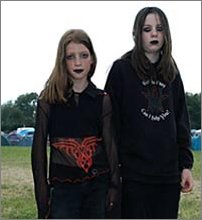The Modern Goth Subculture: Who Are These Youths, and is the Goth Rate of Self-Harm Really Higher Than Normal?
by www.SixWise.com
Goths. If you've walked into a U.S. junior high or high school
recently (or even in the past couple of decades), you've seen
them. The group of guys and girls dressed in mostly black,
some with pale, almost whitish skin, dark lips and nails,
dark flowing dresses and skirts (aka Victorian or Renaissance
era), fishnets, a studded collar or two and plenty of buckles.
The Goths are a subculture that emerged out of the late '70s,
early '80s punk scene. At the heart of the gothic subculture
is their resistance to being defined, which of course makes
describing them somewhat difficult.
|

The Goth subculture emerged from the late-'70s punk
scene and now involves wearing dark clothing and embracing
the darker things in life.
|
Goth.net, a resource set up for the "benefit of the
Goth community," defines Goths as, "A group of people
who feel comfortable within each other's company. There is
no specific thing that defines what you need to do or be to
fit into the Goth scene (except of course the implied black
clothing). People in the Goth scene all have different musical
tastes, follow different religions, have different occupations,
hobbies, and fashion sense."
"Spurned by Normal Society"
The major binding factor among Goths seems to be their sense
of detachment from "normal" society, and a feeling
that they do not fit in within these normal circles.
"Most Goths become Goths because they have been spurned
by 'normal' society, because the way they want to live their
lives does not fit in with how most people are told to live
theirs," reads Goth.net.
Members of the Gothic community define themselves as free
thinkers. While outsiders looking in often see the Goth way
of life as dark and rather morbid, "Goth unashamedly
celebrates the dark recesses of the human psyche," according
to A
Goth Primer Web site, which includes "dark sensuality,
sweeping sadness, morbid fascination, forbidden love, the
beauty of enduring pain …"
"Many people lead unhappy, unachieved lives … Goth
makes depression and angst a lifestyle choice, and that's
art," A Goth Primer continues.
Stereotypes: Are Violence, Paganism and Death a Part of
the Goth Subculture?
The characteristic "Goth" is reclusive and melancholy,
yet smart, and many come from educated backgrounds. Goths
do wear mostly dark clothing and share a general dissatisfaction
with society and/or a desire to be different.
Music, art and literature are also part of the Goth subculture.
Music can include a number of dark, tragic and mysterious
sounds, including bands like Bauhaus, Siouxsie & the Banshees,
Fields of the Nephilim, and the Sisters of Mercy (however,
some also mention a large '80s music following among the Goth
community).
|

In a new study, 53 percent of youths in the Goth subculture
reported self-harming behaviors, compared to 7-14 percent
in the general youth population.
|
Violence, however, is not a part of the traditional Goth
scene, with most members describing themselves as pacifistic,
open-minded and accepting of everyone. And, modern Goths
do not associate with any religion. They are not Satanists,
as is commonly thought, but instead encompass a wide range
of religions, from Christianity to Buddhism.
Goth: Helpful or Harmful?
After the Columbine High School shootings in 1999, there
was considerable backlash against the Goth subculture, as
it was initially thought that the two teen killers belonged
to the group. However, this has been disputed by many, including
those inside the Goth culture, who point out that violence
is not a Goth philosophy.
"Violence is not really what Goths are all about. They're
not particularly out for trouble," said Nancy Kilpatrick,
author of The Goth Bible. "Anybody who plans to kill
other people is troubled. I don't think the focus should be
on what category they fall into."
Still, many wonder whether the dark clothing and focus on
morose music, drawings and conversation can possibly be healthy.
A new study published in the British Medical Journal did
find some telling results. After quizzing 1,258 young people
about self-harm and their links to various youth cultures,
it was found that Goths had the strongest link to self-harm.
While the rate of self-harm among young people in general
turned out to be between 7 and 14 percent, 53 percent of those
linked to the Goth subculture reported self-harm, and 47 percent
had attempted suicide.
"Although only fairly small numbers of young people
identify themselves as belonging to the Goth subculture, rates
of self-harm and attempted suicide are very high among this
group," said Robert Young, lead researcher of the Glasgow
University study.
He did point out, however, that the results were based on
small numbers, as only 25 study participants said they felt
strongly associated with the Goth subculture.
It's suspected that, rather than the Goth subculture influencing
teens to harm themselves, youths who are prone to this behavior
may be drawn to the group.
"One common suggestion is they may be copying subcultural
icons or peers," Young said. "But since our study
found that more reported self-harm before, rather than after,
becoming a Goth, this suggests that young people with a tendency
to self-harm are attracted to the Goth subculture."
In this way, the subculture may actually be helpful.
"Rather than posing a risk, it's also possible that
by belonging to the Goth subculture, young people are gaining
valuable social and emotional support from their peers,"
Young said.
To add to the mystery surrounding Goths, it turns out that
the "real" Goths may actually be the ones who say
they are not. According to Goth.net:
" … Truth be told that many people who are Goth
or who associate themselves with the scene don't call themselves
Goths because they find it too limiting or find that others
stereotype them based on that one label, rather than seeing
the sum of the parts.
Too often there are people that try too hard to fit the
label and completely pass by the fact that being Goth is
as much about being yourself and finding your own path rather
than rigidly trying to fit the stereotypes."
Recommended Reading
The
Choking Game: The Deadly Game Surging in Popularity Among
(Even the Smartest) Kids & Teens
Crystal
Meth Abuse Skyrocketing in Big Cities to Small Towns: Why,
and What are the Signs and Risks?
Sources
Reuters
April 17, 2006
New
Scientist April 14, 2006
Courier
Post Online April 8, 2006